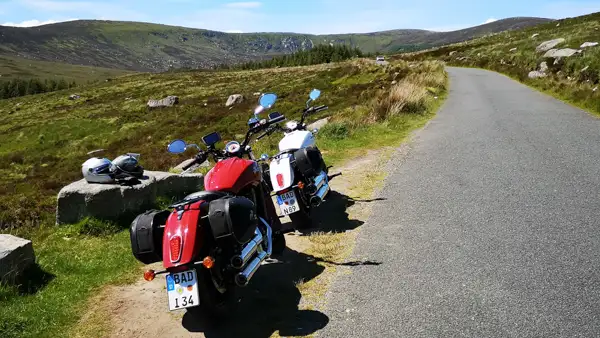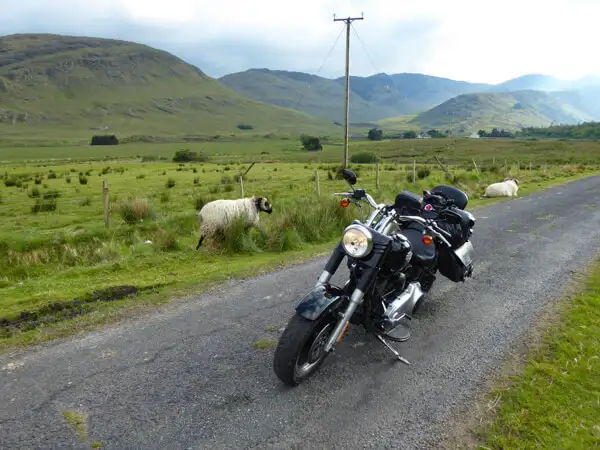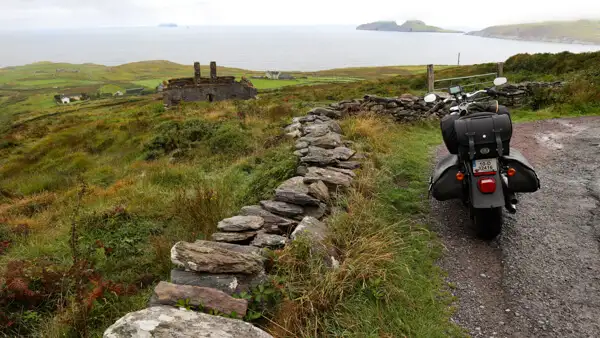I always have customers in our motorbike rental shop in Ireland (update: we have closed the shop after number of years) who start their first holiday with worries. Many of our clients have never ridden on the left side before.
To give you an idea of what to expect, I’ll give you some useful information and tips along the way.
Disclaimer: I have been riding motorbikes in Ireland, Scotland and England for years, but I am not a licensed driving instructor and therefore my statements are not legally binding. I am only stating my personal experiences here without any obligation.
Page Contents (click line to jump the text)

Where does left-hand traffic apply?
You will be surprised how many countries in the world have left-hand traffic – that’s over 60 countries! You’ll probably never visit most of them, but some, like New Zealand, Australia or Thailand, may already be on your bucket list.
In Europe, left-hand driving applies in the Republic of Ireland and the British Commonwealth countries of Northern Ireland, England, Scotland, Wales and the Isle of Man. Gibraltar is part of the Commonwealth, but right-hand traffic applies there. The islands of Cyprus and Malta also have left-hand traffic.
Driving direction and lanes
You should drive in the left-hand lane. Overtaking is done in the right lane.
On motorways, you must drive on the left and overtake on the right. The on-ramp and off-ramp are also on the left. So you drive onto the motorway to the right.
We are often asked what a yellow sign with the inscription “Detour” means? This is the diversions sign, e.g. for road construction work.
Right of way
Despite the left-hand traffic, in Ireland, as in Great Britain, the right-of-way rule is “right before left”! Most of the time you don’t have to think about it, because at most intersections the right of way is regulated.
The signage is very similar to that in Germany and therefore easy to understand. You will spontaneously recognise right-of-way signs, one-way streets, no-entry signs and the like.

Roundabout
The most common roundabouts are driven through in a clockwise direction, i.e. around to the right. You therefore turn left into the roundabout. The traffic in the roundabout has right of way, as in Germany.
Small roundabouts are usually single-lane and only a round spot of colour in the middle of the intersection – but recognisable by the signage. Roundabouts in cities tend to be multi-lane. Usually, “right-turners” should then use the right lane, i.e. the inner lane of the roundabout.
Urban traffic and parking
No-parking signs are easy to recognise, as are signs telling you where you can park but you have to buy a parking ticket.
Less well known are kerbs painted yellow: one line means no parking, two lines mean no stopping. This is taken seriously and parking tickets are also sent to Germany – with hefty reminder fees.
Another tip on parking: If you drive into a parking bay on the right to take a break, there is a high risk that you will drive off again on the right! It’s better to park on the left, then drive off on the left again!
Speed limits on the isle of Ireland
The speed limit is 50km/h in built-up areas, 80km/h on country roads (R and L), 100km/h on national roads (N) and 120km/h on the motorway.
Motorways are usually well developed, N-roads too, but on R and L roads you will often not drive the 80km/h limit at all. The roads are often narrow and “bumpy” and 60-70km/h is usually fast enough.
Be aware that if you are going to Northern Ireland, you will be entering the UK where the speed limit is miles per hour. In towns 30mph (approx. 48km/h), out of town 60mph (approx. 95km/h), and on the highway 70mph (approx. 113km/h).
Alcohol limit – and other substances
The alcohol limit is 0.5 per mille. For most people this means one large beer with dinner, but the second one can be critical.
In the land of cosy pubs this may seem surprising, but the police (Garda) are very strict and fines are expensive.

Caution: If you rent a vehicle, whether motorbike or car, the insurance conditions will state that no !!! alcohol or other mind-altering substances are allowed. alcohol or other mind-altering substances (medicines, drugs,…) are allowed, otherwise the insurance coverage may be cancelled – which can be catastrophic in case of an accident! My tip: Save the beer for the evening when you can eat and drink in the hotel/B&B or when you are on foot.
Is it easier to drive on the left by motorbike or by car?
Left-hand traffic is easier with a motorbike. All the switches and buttons are in their usual places and even on narrow roads you rarely have the feeling that things are getting tight.
In a rental car, you may sit on the right, change gears with the left and feel completely wrong for a long time near the centre line in the left lane.
With your own car (left-hand drive), everything is in the usual place, but Irish roads can be very narrow. On the left comes the hedge and the lorry from the front slides over the centre line – you have to practise that for a while, until then it stresses you out.
So, the bike makes it comparatively easy for you to ride in unfamiliar left-hand traffic! You’ll soon get the hang of it.
Dare! And have a great trip in Ireland.
More interesting articles for you
MOTORBIKE ACCIDENT ON YOUR IRELAND TRIP? – AVOIDANCE AND PREPARATION!
MOTORBIKE BREAKDOWN ON THE IRELAND TRIP – WHAT TO DO?
PREPARE YOUR BIKE FOR YOUR TRIP TO IRELAND – BE WELL PREPARED AND SAFE ON THE ROAD!
HOW CAN I PREPARE MYSELF AS A RIDER FOR THE IRELAND MOTORBIKE TRIP?
Photo credits cover photo: Motorcycle on a narrow road in the mountains, photo by Ulrich Knüppel-Gertberg (www.irland-insider.de, www.ireland-insider.com)